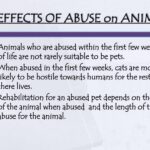Animal cruelty is a harrowing reality that occurs in many forms, from neglect and abandonment to overt acts of violence. It is a pervasive issue that often goes unnoticed until a compassionate individual takes it upon themselves to investigate these heinous acts. Enter the animal cruelty investigator, a crucial figure in the ongoing battle against animal mistreatment. Understanding the role, responsibilities, and complexities faced by these professionals provides insight into the broader implications of animal welfare.
Duties of an Animal Cruelty Investigator
Animal cruelty investigators are often on the frontline, acting as both detectives and advocates for vulnerable creatures. Their primary duty is to investigate reports of abuse and neglect. This often begins with gathering evidence, which may involve visiting locations where animals are believed to be mistreated. Investigators observe conditions, take detailed notes, and may photograph evidence of wrongdoing. This initial step is critical, as the evidence collected could lead to legal action against offenders.
Furthermore, animal cruelty investigators work closely with local law enforcement and animal control officials. They may provide testimonies in court, serving as expert witnesses when cases of animal abuse are brought to trial. The collaboration extends beyond the legal framework; investigators often coordinate with veterinarians to assess the health of animals in distress. Medical professionals provide crucial documentation that illustrates the extent of the abuse, illustrating what the animals have endured.
Additionally, reporting to relevant organizations or advocates is a vital duty. After thorough investigation, these professionals compile reports that summarize their findings, helping to initiate preventative measures and education to the broader community. In tandem with community outreach, the role also encompasses the need to educate the public about responsible pet ownership and the legal implications of animal cruelty.
Skills Required
To excel as an animal cruelty investigator, a unique skill set is essential. Strong analytical skills are vital, enabling the investigator to assess evidence meticulously. They must possess an acute attention to detail, as small nuances can be pivotal in determining the severity of a case. Empathy is another key skill; understanding the emotional toll that neglect and abuse take on animals fuels the investigator’s drive to advocate for change.
Moreover, interpersonal skills are crucial when working with various stakeholders. Investigators often liaise with the public, law enforcement, and animal welfare organizations. Communication must be clear, succinct, and sensitive, especially when addressing the trauma experienced by animals. The ability to articulate findings in a compelling manner is particularly important, as it affects the likelihood of prosecution and public awareness.
Investigation tactics also require a certain level of physical resilience. The job can be demanding both physically and emotionally, as it may necessitate handling distressed or even aggressive animals. Comfort with a range of animal species is paramount, as the diversity of cases can span from household pets to wild animals found suffering in urban environments.
Challenges Faced
Despite the noble intentions behind the role of an animal cruelty investigator, challenges abound. One pressing issue is the emotional toll of encountering cases of severe abuse and neglect. Witnessing the effects of cruelty firsthand can lead to compassion fatigue, a condition where caregivers and advocates become overwhelmed by the suffering they witness. This emotional burden can undermine an investigator’s effectiveness over time, necessitating strong support systems and coping strategies.
Additionally, investigators often face legal and bureaucratic hurdles that can impede their efforts. Laws surrounding animal welfare vary significantly across jurisdictions, which can complicate investigations. Lack of resources or funding limits the scope of their work, forcing these professionals to prioritize cases based on severity rather than need. In some instances, the legal system may not provide adequate consequences for abusers, creating a frustrating cycle of impunity.
Cultural attitudes also pose significant barriers. In certain communities, there may be ingrained perceptions that normalize neglectful or abusive behavior towards animals. This perspective can manifest in resistance towards intervention, complicating the investigator’s mission to bring about legislative change and promote a more humane society. Thus, education remains a crucial endeavor; fostering an environment where animal welfare is prioritized requires shifting deeply rooted beliefs.
Lastly, the evolving landscape of animal justice work means that investigators must stay informed of the latest developments in animal law, rehabilitation techniques, and societal trends. Continuous education is essential for adapting to new challenges and emerging forms of cruelty, whether it arises from technological advancements or changing societal norms.
Conclusion
The role of an animal cruelty investigator is multifaceted, encompassing investigative work, legal involvement, and advocacy. They serve as protectors of those who cannot speak for themselves, tirelessly working to combat the injustices faced by animals. While the challenges they encounter are formidable, their unwavering commitment to animal welfare ignites hope for change. The complexities of this profession reflect not only the struggle against cruelty but also the profound fascination humanity holds towards the well-being of all living creatures. As society continues to grapple with issues of compassion and justice, the work of animal cruelty investigators must remain at the forefront of our collective conscience.







